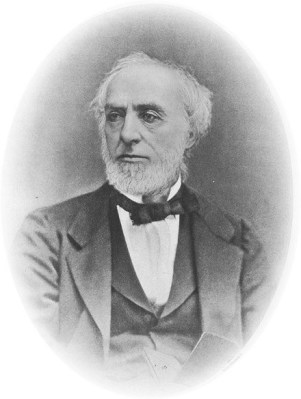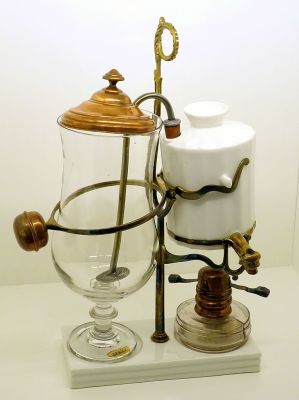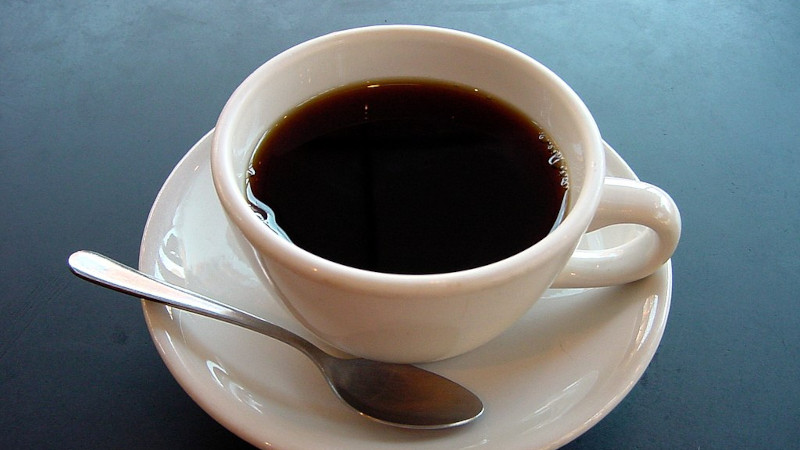In the study of genealogy it’s common to find people who will go to great lengths involving tenuous cross-links to establish royalty or famous figures such as George Washington or William Shakespeare in their family tree. There’s no royal blood and little in the way of fame to be found in my family tree, but I do have someone I find extremely interesting. One of my great-great-grandfathers was a Scottish engineer called James R Napier, and though his Wikipedia entry hasn’t caught up with this contribution to 1840s technology, he was the inventor of the vacuum coffee pot.
 He was born in Glasgow in 1821 and was the son of a successful shipbuilder, Robert Napier, into whose business he followed once he’d received his education. He’s probably most well known today for his work in nautical engineering and for inventing Napier’s Diagram, a method for computing magnetic deviance on compass readings, but he was also a prolific engineer and author whose name crops up in fields as diverse as air engines, weights and measures, drying timber, and even the analysis of some dodgy wine. The coffee percolator was something of a side project for him, and for us it’s one of those pieces of family lore that’s been passed down the generations. It seems he was pretty proud of it, though he never took the trouble to patent it and and thus it was left to others to profit from that particular invention.
He was born in Glasgow in 1821 and was the son of a successful shipbuilder, Robert Napier, into whose business he followed once he’d received his education. He’s probably most well known today for his work in nautical engineering and for inventing Napier’s Diagram, a method for computing magnetic deviance on compass readings, but he was also a prolific engineer and author whose name crops up in fields as diverse as air engines, weights and measures, drying timber, and even the analysis of some dodgy wine. The coffee percolator was something of a side project for him, and for us it’s one of those pieces of family lore that’s been passed down the generations. It seems he was pretty proud of it, though he never took the trouble to patent it and and thus it was left to others to profit from that particular invention.
Vacuum Coffee Pots: Impressive, But Slooow
Just what is a vacuum coffee pot, and what makes it special? The answer lies in the temperature at which it infuses the coffee. We take for granted our fancy coffee machinery here in the 21st century, but a century and a half ago the making of coffee was a much simpler and less exact process. Making coffee by simply boiling grounds in water can burn it, imparting bitter flavours, and thus at the time a machine that could make a better cup was seen as of some importance.

The Napier coffee pot has two vessels, one of which is sealed save for a tube that passes from near its base into the bottom of the other which is open to the atmosphere. The sealed vessel is filled with water and heated, and the second is filled with coffee grounds. As the water gets hot, it produces water vapour that slowly displaces the hot water through the tube into the coffee grounds. Eventually nearly all the water has been pushed out, at which point the heat is removed and the device’s party piece performance happens. The remaining water vapour condenses, producing a vacuum that quickly and noisily sucks the coffee back into the first vessel. There is usually a gauze filter on the tube to prevent the grounds being sucked through with the liquid.
The key to the process is that the water touching the grounds never boils, and thus the coffee never reaches a temperature at which it degrades. James R’s original pot had two separate vessels side-by-side, but it’s more normal to see them today with one vessel atop the other. A few years ago I bought my parents a Bodum vacuum coffee pot because of the family association, and while I can say that it made a very nice cup of coffee the whole process was a bit of a tedious performance once the novelty had worn off.
As an engineer I am fascinated by my ancestor’s work, and while my field of electronics would have been unknown to him in the 1850s, I’m sure had he been alive in this era he’d have been equally at home with the tools on my bench. Perhaps the most interesting reflection from researching this piece comes not from his work though, but from considering the difference of opportunity between the two centuries.
If I were to assemble all my great-great grandparents in the same room they would be a diverse group, alongside the engineer would among others be a policeman, at least one textile worker, a shopkeeper, and a few farm workers, from various corners of the British Isles. Several of their children and grandchildren became engineers too, I carry the concentrated engineering DNA of more than one family, but they were better able to realise that potential because of the increased access to education that came with the twentieth century. As I savour my coffee I realise that maybe my view of technological advancement has overlooked the obvious, before all the semiconductors and computers came the opportunity for advancement based on achievement rather than wealth or patronage.
Coffee cup: Julius Schorzman, CC BY-SA 2.0.
















But did he knew about RFC 2324?
According to my knowledge and to Wikipedia, it’s a German invention:
This type of coffee maker is also known as vac pot, siphon or syphon coffee maker, and was invented by Loeff of Berlin in the 1830s.
Probably one of those things invented around the same time by multiple people. See also television and flight.
Start an edit war with English Wikipedia. :)
I am a Scot. My parents used to buy such coffee percolators in sale rooms in Glasgow and we used them to make wonderful coffee. They knew it to have been invented by the Scot Alexander Napier. I have one on a shelf in my house as I write. They came on a usually ceramic stand with a thin class globe and a ceramic or glass or silver plated coffee container connected my a metal S-shaped tube with a filter at ine end in the coffee and the other end plugged into the globe by a cork to make it airtight. The globe contained a small amount of water kept boiling by a spirit lamp, which passed steam into the coffee keeping it hot and percolating. When the lamp was extinguished, a vacuum was c treated in the globe and the coffee minus the grounds whooshed into the globe, from which the coffee was poured. It was commonly used in Victorian times.
My ancestors in Scotland are said to be in the slave trade. I haven’t look deeper.
But when my great,great, great grandfather got to North America, the story gets interesting. I got nothing from my father or grandfather, all I know comes from the internet. I can look in books and read about them.
Great great grandfather was a minister from Scotland, he didn’t want to go to Red River, thensaid only for a short time. But when he met my Metis great, great grandmother, he never left.
Maybe ten years a book came out about Scottish men who went abroad and made good. Alexander is in it.
There are for sure several Napiers and their inventions in the museums in Glasgow and Edinburgh.
It’s all about timing. My grandfather was a coal miner, my father was a coal miner, I worked on NASA computer systems.
That seems to be the story for everyone. Switch from digging up fuel to burning up fuel for a living.
My grandfather was a coal mining engineer…my father was a shoe salesman…I became the engineer. It skips a generation. :)
One cleaver feature of that coffee maker that wasn’t mentioned is how the heat is removed at the right time. As it turns out, the water reservoir is balanced over the alcohol flame. When the water size is empty, the reservoir tips up, which releases the alcohol burner cap to pivot down and cover the flame causing the flame to go out. I have a coffeemaker stamped H Eicke Berlin I inherited that uses the same method to put out the flame after the hot water has passed through the grounds. It’s from around 1908 but doesn’t use the vacuum.
All I want is a proper cup of
Coffee made in a proper vacuum coffee pot
I may be off my dot but I want a proper coffee in a proper vacuum pot
Iron coffee pots and tin coffee pots, they are no use to me
If I can’t have a proper cup of coffee in a
Proper vacuum coffee pot, I’ll have a cup of tea.
No matter who was the original inventor, your ancestor, Loeff or Madame Vassieux, I am grateful today that they did. I bought one of these:
https://www.amazon.com/KitchenAid-KCM0812OB-Siphon-Coffee-Brewer/dp/B00Y2KGYPE?th=1
actually as an very inexpensive clearance item and I’m using it every day! It makes a wonderful smooth cup of coffee and is a pleasure to see operating.
Your Great Great Grandad did get get some acknowledgement:
Napier never patented his brewer, but it was quite popular for some years, and was presented an award by The Institution of Mechanical Engineers in 1856 for “exhibiting the Napier Coffee Pot and for his gratuitous entertainment of their guests with coffee” at the first meeting of the institution in Glasgow.
Makes me curious about family histories. I have a line of inventor/tinkerers on one side where getting a patent is kind of a rite of passage, and a machinist & farmers on the other side. Along with the requisite collection of those that made money in less savory ways, much like Michael Black. But it is also very clear (with almost 800 years of known family history in a few lines/areas) that those with an opportunity to be exposed to higher education were far far more prosperous.
So we are related then, howdy cousin! The truth is that everyone with relatives in the UK from more affluent families is related to each other.
True. One of his daughters married the son of the List who arrived from Germany in the mid 19th-century. Probably the sister of your ancestor :)
There’s a coffee shop near me with one of those on the counter. If you want a cup from it, the price is about double their regular brew
The most notable relative I can think of off the top of my head was my grandfather on my dad’s side of the family. He was one of the early employees of Polaroid (and a very good friend of Dr. Land), was responsible for designing their main factory, and was VP of manufacturing. The living room at their house, dad always freaked out when I went in there, because he had it drilled into his head when he was a kid that it was a Forbidden Zone; this was because when foreign manufacturing partners wanted to cut deals with Polaroid, that’s where they went! Instead of grandpa traveling abroad to meet with partners on-site (which was what they did initially, until grandma was getting sick of grandpa always away from home), they came to his house in Needham where they were welcomed as guests and used the living room to hash out manufacturing deals. The home now belongs to a different family… I wonder if they know the significance of that room in the history of photography?
For the record, he retired during development of Polavision. Apparently there were difficulties in manufacturing (low yields? iirc) and grandpa knew that their big competitor, Eastman Kodak, was doing R&D on what would become digital photography. He tried to suggest to Dr. Land that they should try and beat them to the punch, but Dr. Land was all “Chemical technology is the future!” and uh that was when grandpa retired.
My uncle Paul worked for Polaroid as the plant manager for the main factory his dad designed, and oversaw the disassembly of the place back in 2001 when the company went out of business. It’s now a community college iirc.
My granddad, along with some diminutive Canadian radar whiz-kid named Gow, was one of the progenitors of high fidelity audio. Think big blue wattmeters. :D When I was a little kid I didn’t understand why my friends’ parents didn’t have their names on their hi-fi systems. It wasn’t until The Old Man™ took me around the factory in NY that I glommed onto the notion that that’s what he did for a living.
Last year I walked past the Impossible factory in Enschede, Netherlands, now the Polaroid factory. Just sometimes these things can return.
If patent wars float your boat.
Look up the story behind the Polaroid Instamatic.
A long drawn out David & Goliath battle.
But in this one David was not the Victor.
Funny, the basic design of the final idea, resembles an American Chemex style coffee maker. I saw one once in a Starbucks. Oh and James Bond would drink three cups of coffee made that way with his breakfast when home. Oh and Jenny, the fact that one of your great relations invented many things, including that diagram is important.
> a Bodum vacuum coffee pot
That’s quite a different system, and it makes terrible coffee mind you. The water is forced up by the boiling, and it requires quite a lot of boiling to occur before it wants to go up, whereas in the Napier pot is siphoned out half by gravity, so the Bodum pot ends up burning the coffee with piping hot water.
Used one of these in a small bar for a while, and it was always the nastiest brew. Almost as bad as American coffee.
I’ve used a Hario, once the water is up the top you wind the temp back so it just stays up there – definately not boiling, and then add the coffee. Gimmicky and there are better options but makes an OK brew.
Might try that next time I use one. Ours was loaded up with coffee before it was put on the stove, making it a sort of half-percolator which soaks the coffee in steaming hot water and then pulls it back through.
The term “siphon cofffee maker” is a misnomer in these cases because it pushes water uphill. In the Napier pot, the two containers are side by side so at least half the water does actually siphon into the other vessel with little pressure just from the expanding air, and the process reverses before it starts burping (much) steam through it.
Hey! America can have nice coffee.
The percolator is an American invention. Whatever coffee you use, it won’t come out nice.
By adjusting parameters/technique, you can definitely make coffee from a (stovetop) percolator come out nicer than the crude drip machines which are the main american alternative. Percolation is often considered not as good as what you can get by e.g. french press, but done right it can work pretty well with common coffee.
Ideally, I grind it coarse enough to restrict flow but not clog the perforations in the metal, then use quite a bit of coffee and water rather than trying to do a partial batch. That tends to keep the grounds soaked in less-than-boiling temperature water, and I take it off immediately once it’s reaching desired strength. It ends up the least acidic and least bitter of a variety of methods I’ve tried for using up cheap supermarket medium and dark coffees. Getting the acid/bitter (~=extraction) axis and the strength/concentration axis wrong are the two basic things that ruin a lot of coffee at the level we’re talking about here, and a percolator makes them simple.
Percolation like this is inefficient both in power and in quantity of grounds needed, and is prone to leaking if I use too much heat. Still, not bad for simple, inoffensive coffee that’s strong enough to still have flavor instead of tasting like brown water. I would compare it to heated immersion with slow stirring, maybe.
True that, dude. I use a manual drip and bring my water to near boiling. My folks had a clear glass percolator that I enjoyed watching as it made nasty tasting brew.
No it’s not, they make a boiling one too. They make a proper vacuum pot, and having observed it more than once I can say that the water never boils.
Meanwhile on another branch of your family tree, more engineers who’s company eventually built the 3,500hp Napier Sabre: https://en.wikipedia.org/wiki/D._Napier_%26_Son
Different Napiers, sadly.
Ooh fancy
I love it!
By chance, I found a beautiful vacuum pot with both the upper and lower glass vessels made of striated glass (like a pumpkin). It had chrome stripes on the glass that were in almost perfect condition. I had never seen one like it and I got it at the thrift store for $5 (after finding the lower decanter in another part of the store). Using the wonderful baharris.org site, I was able to identify it as a vintage 1936 MacBeth-Evans Thermo Glass Vacuum Pot: https://baharris.org/coffee/Vintage/MacBeth_Thermo_Glass.jpg
This is a PS: look up Napier coffee and you will fine a photograph if just such a device.